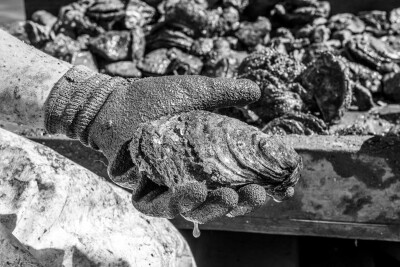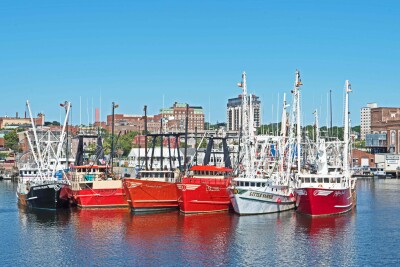Northeast
Paper core lightens tuna boat; mold adapts to beam demands
It's been a while in the making, but this spring, a lot of people could be talking about the Emme, a Northern Bay 38 tuna boat, when she is hauled from the boatshop at Otis Enterprises Marine in Searsport, Maine, and slides into Penobscot Bay.
Plenty of new lobster boats are launched into Penobscot Bay, but not many tuna boats. There won't be any mistaking the Emme for a lobster boat, not with the 45-foot-long green stick punching skyward from the back of the extended cabin. Plus, the two 21-foot outriggers, a bandit reel on the stern starboard quarter and holders for 13 rods around the wash rail aren't part of the fishing gear of any lobster boat.
There's a lot of attention to detail on the Emme. From the powder-coated mast holding radar, lights and a KVH TracVision M3 satellite antenna, among other things, to the stainless steel extendable davit on top of the house.
The boat was built for Anthony Siniscalchi, out of Atlantic Beach, N.Y. Besides tuna fishing, Siniscalchi has a lobstering permit, so the davit, with its hauling block, can be pulled out to guide pot warp to the hauler, or pushed in when tuna fishing. When a large tuna is caught, a line will be run through the door on the transom's starboard side, then forward and over the davit's block and down to the hauler on the main bulkhead. With the hauler engaged, the tuna will be pulled through the door and onto the deck.
When tuna aren't biting, Siniscalchi can watch a 20-inch TV monitor that folds down from the main cabin's overhead. Up in the fo'c'sle, there's a 19-inch monitor so the crew won't miss out on their favorite programs. But the eye stopper when you enter the cabin isn't the TV, it's the nicely appointed paneling with radiused surfaces.
The convex corners in the cabin and forepeak are formed using cored panels made of honeycombed phenolic-resin-impregnated Kraft paper between thin facing surfaces of okoume plywood. It's a product manufactured by Tricel Honeycomb. Most cored panels cannot be bent; these can. Keith Otis says it's the first time his shop has used the Tricel product, and he's not aware of other Maine boatshops using it.
Since the core structure is paper and 95 percent open space, there's a tremendous amount of weight savings.
"Using Tricel, we are getting rid of 1,500 pounds over using plywood and glass," Otis says. "And if it gets wet, it will dry out in a matter of days," says Travis Otis, Keith's son and the one who's done most of the work on the boat. He adds that they tried to use the Tricel product wherever possible.
Travis acknowledges that while the Tricel panels are a third the weight of plywood, they are three times as expensive. But, he adds, "you won't be using as much fuel, and over time, you'll get it back and possibly more."
With the weight savings, the boat's builders hope the Emme gets up to 30 mph. To do that, she has a 670-hp Cummins QSM11 and a ZF marine gear with a 1.75:1 ratio that spins a 28" x 32" four-bladed prop.
In Wedgeport, Nova Scotia, Wedgeport Boats is due to launch one of its 44' 11" x 20' Cape Island–style lobster boats in mid-April. The boat is going to a lobsterman just outside of Digby, in Annapolis County, Nova Scotia.
For power, the boat will have a rebuilt 425-hp 60 series Detroit Diesel. There are two live wells that together hold 50 crates of lobsters, says Skip Muise, the boatshop's foreman.
The boat has a solid fiberglass hull with a plywood and fiberglass deck, supported by deck beams of 2 x 6 pressure-treated timbers, running fore-and-aft on 16-inch centers.
The mold the hull came from can be expanded from 18 to 24 feet wide. "We are stuck with 24 feet," Muise says, "because our doors are 24 feet wide, but the guys would like it wider. With the local guys, it's the bigger the better."
Other fishermen like to stay at 21 feet because, "they can carry all the traps they are allowed on dumping day," Muise says, "so why go to 24 feet?" And once a hull is pushed out past 21 feet, the costs go up quite a bit because of increased laminate costs, and the superstructure is more expensive. One thing that would be gained is bragging rights: "My boat is bigger than yours."
— Michael Crowley
West
Twin bowpickers get twin jets; halibut fleet's annual checkup
By the first week in May — just in time for the Copper River salmon opening — a pair of 30-foot fiberglass bowpickers will be leaving Freddy's Marine (formerly Freddy's Painting and Fiberglass) in Homer, Alaska, for sea trials.
The two boats will look exactly the same, except when you drop into the engine compartment. The boat for George Saragin of Spokane, Wash., will have a pair of Volvo Penta diesels turning 213 Hamilton water jets.
Keith Klockenbrink, of Palmer, Alaska, will have the same Hamilton jets in his bowpicker, but two 370-hp Chevy gasoline engines will power them.
Fred Martushev, owner of Freddy's Marine and the hull's designer, describes it as a planing hull with a reverse chine or gull wing. The reverse chine starts out as 6 inches wide at the transom, carries that width to about amidships and then starts tapering down to nothing at the stem.
One thing that makes the hull different is the compound curve in the bow sections. Martushev says it is a radius-V shape that carries nearly halfway back and then transitions to straight-line-V sections.
"It's a compound curve to a straight V," says Martushev. "Maybe there is another one like it, but I haven't seen it. You need the straight V to plane, but the radius V in the front will cut the water better without heavy pounding."
Inside the solid fiberglass hull are four 2 x 6 fiberglass-covered stringers and bulkheads of plywood covered with fiberglass. The decks will be foam cored.
Martushev says the hulls have about 5 inches more freeboard than other boats of the same size. The extra freeboard allows him to bring up the deck height, which gives more room in the engine compartment and 30 to 40 percent more space in the fish hold.
The outside front of the cabin will feature a rounded surface without any square corners and flat surfaces.
In Seattle, the crew at the Fishing Vessel Owners Marine Ways was busy getting the last few boats in the halibut fleet ready to go north for the opening of the season in March. Though the weather has been so bad, most of the boats are waiting for the storms to clear before heading out of the Ballard Locks and steaming into the Gulf of Alaska and the Bering Sea.
Fishing Vessel Owners Marine Ways hauls and goes over the halibut boats on a yearly basis. That's good because some of them were built in the early 1900s. The schooners are the oldest, beginning with the Tordenskjold, built in 1911. The Seymour, Vansee and Polaris were all built in 1913; the Grant was built in 1925, the Northern in 1927 and the Aleutian in 1928. There are others, but those are the oldest.
In terms of more youthful halibut boats, the wooden-hulled house-forward Memories, built in the 1940s, was in for general maintenance and bottom paint.
Also hauled out on the railway was a twin-screw Trident Seafoods–owned power scow, built about 1945. The tail shafts had to be hauled out and repaired. New stern bearings were installed and the stuffing boxes re-babbitted. Once everything was put back together, the two engines would be realigned.
Farther along the coast in Bandon, Ore., H & F Custom Boats has nearly completed its first 29-foot hull for a tuna fisherman on Hawaii's island of Maui.
The boat will have a pair of 250-hp at 4,000-rpm MerCruiser diesels matched up with Bravo II outdrives with 19 3/4" x 25" props.
That power package will easily get the 29-footer on plane and then kick it along until it's pushing 45 mph, says Harold Montgomery, owner of H & F Custom Boats.
Montgomery used to install MerCruiser gasoline engines in the boats that he builds, but after installing his first MerCruiser diesel six or seven years ag
o, the gas engine has pretty much disappeared from his boatshop. The first diesel MerCruiser went in a boat fishing out of Hawaii, and Montgomery says the engine is "flawless. They haven't had a problem with it."
His says each diesel on the new boat will burn about 9 gallons per hour at cruising speed.
There will be accommodations for two in the forward pilothouse, which will have air conditioning. An insulated fish hold will be in the center of the boat.
— Michael Crowley
South
Tides slow down boat repairs; shrimper turned into scalloper
In February, many southern boatyards were busy getting commercial fishing boats ready for the Mid-Atlantic scallop fishery, which opens March 1.
Smith's Marine Railway in Dare, Va., had the Stephanie B, an 86' x 24' wooden scalloper, on the rails. Smith's Marine Railway services most of the wooden boats in the scallop fleet out of Seaford, Va., where two large East Coast scallop businesses are based.
The Stephanie B, which was built by St. Augustine Trawler in St. Augustine, Fla., in the early 1980s, is owned by Benavidez & Sons of Seaford, Va.
The Juanita B, another Benavidez-owned wooden scalloper, was due to be hauled once the tide was big enough to float the Stephanie B off the rails.
In February, Chesapeake Bay was having extremely low tides, and this slowed the movement of boats on and off the rails. This was particularly true for boatyards with one railway, like Smith's, that are located on a relatively shallow creek, and most boatyards are located on the sheltered creeks.
Benavidez has three wooden scallopers and like clockwork every February, Smith's services the boats. The work on the Stephanie B included replacing a damaged prop with a spare, installing a new stern bearing and putting on 24 zincs. The zincs were purchased from Marshall Manufacturing Co. of Atlantic, Va. With the cost of zincs steadily increasing, Smith's Marine Railway keeps a close eye on prices for zincs and has found Marshall to be far and away the better deal.
Up in the scalloper's forepeak, a new cross frame was added and four were re-bolted with stainless steel bolts. The cross frames are drift bolted into the keel and then fastened to the ribs. "We've done this on all the St. Augustine trawlers. At their age — they all were built around 1980 — they've had a pretty hard life and start breathing up there [in the forepeak]. In some boats, we've put in as many as eight to 10 new cross frames," says the boatyard's Jamie Smith.
The Stephanie B was previously named the Carolina Tarheel and was owned by Seaford Scallop Co. The company still has two wooden boats, which Smith's maintains.
The next boat scheduled to come out of the water after the Juanita B was the Godspeed for routine maintenance. Rockport Marine of Rockport, Maine, built the Godspeed as a replica of one of the three boats the English sailed across the Atlantic to start American's first permanent settlement in 1607. The boat is kept at Virginia's Jamestown Settlement, a museum of 17th-century history and culture.
The Godspeed will play a major role in celebrating the 400th anniversary of the settlement of Jamestown this year. The boat is scheduled to be on the rails the first of March.
Smith's Marine Railway specializes in wooden boat work, so if you have a steel boat you might go to Colonna's Shipyard on the Eastern Branch of the Elizabeth River in the Port of Hampton Roads in Norfolk, Va.
Wanchese Fish Co., out of Wanchese, N.C., had the Good News II on the rails at Colonna's Shipyard. Wanchese Fish Co. recently purchased the former shrimp boat and converted it to a scalloper. The Good News II was built at Kennedy Shipyard in Galveston, Texas.
Wanchese Fish Co. did most of the conversion work but is having Colonna's Shipyard inspect the bottom and do any work that's necessary. William Daniel, president of Wanchese Fish Co., says the waterline needs to be marked on the boat, and the steel hull will get a high-pressure wash job. Zincs in the 70- to 20-pound size range will be installed, as well as a new sea chest and transducer mount.
In addition, the keel cooler piping and strainers will be cleaned out; the hull will be sand swept and painted. But Daniel says the company is not sure how extensive any repair work will be.
Colonna's Shipyard is a full-service repair facility. It was founded in 1875 and is the oldest full-service family-owned private shipyard in the United States.
The shipyard has a 17,200-ton Navsea 1625–certified floating dry dock, a 2,800-ton floating dry dock, two marine railways, and a full array of shops and repair facilities. Colonna's Shipyard can do a wide range of repairs, overhauls and conversion work on ships up to 850 feet long.
— Larry Chowning
Correction
Around the Yards in March misstated several facts regarding the scallop boat Pursuit. The 3412 Caterpillar main engine produces 650 hp. The generators are 65 kW, and the winch engine is a 385-hp Caterpillar C-12. The boat's dimensions are 94' x 25' x 11.5'. Juan Araiza and Bill Wells are equal partners in the boat.






